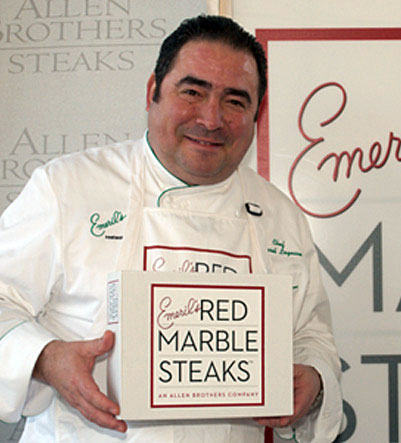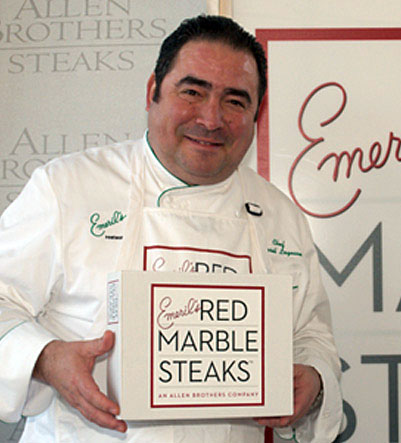 Emeril Lagasse, industrial beef’s new best friend(Red Marble Steaks)Far be it for me to lament the state of food television. Don’t get me wrong — watching a man lurch about a stage kitchen, bellowing canned slogans (“Bam!”), and pandering to the studio audience, destroys my appetite. But people receive pop culture in multiple and unpredictable ways. One person’s blustering jackass is another’s pied piper. For all I know, Emeril Lagasse is inspiring millions to get busy in their home kitchens. If so, I salute him.
Emeril Lagasse, industrial beef’s new best friend(Red Marble Steaks)Far be it for me to lament the state of food television. Don’t get me wrong — watching a man lurch about a stage kitchen, bellowing canned slogans (“Bam!”), and pandering to the studio audience, destroys my appetite. But people receive pop culture in multiple and unpredictable ways. One person’s blustering jackass is another’s pied piper. For all I know, Emeril Lagasse is inspiring millions to get busy in their home kitchens. If so, I salute him.
That said, I wish he would use his (presumably) vast influence to inspire his fans to think critically about the food system. I’m not suggesting that he lead his team of cameras inside an enormous feedlot where thousands of cows stand hoof-deep in their own waste, fattening up on liver-destroying corn and all manner of dodgy stuff, including “chicken litter” and the waste from the ethanol-making process. But even in the context of his show, he could do plenty to inspire people to think. Say what you will about Great Britain’s biggest food celebrity, Jamie Oliver; he uses his media platform to educate people about the trouble with the industrial food system and to promote alternatives to it.
What do we get from our biggest food-TV star, Emeril? True, he did just come out with a book called Farm to Fork, which “brings out the ‘green’ in Emeril with recipes that will inspire cooks, new and old, to utilize organic and locally-grown produce.” But like his fellow food-TV megastar Paula Dean, Emeril has officially latched onto the teat of the conventional meat industry. He has just launched a joint marketing venture to sell “Emeril’s Red Marble Steaks” to his legions of fans.
Emeril’s partner is Chicago-based Allen Brothers, a wholesaler of high-end, conventionally raised beef. Allen Brothers sells beef rated “USDA prime” — judged by USDA inspectors to have the highest degree of fat marbling — to fancy steakhouse chains across the country.
And where does the company purchase said beef? A glowing 2006 profile in the New York Sun explains, “Allen Brothers has contracts with the major [beef] packers to ensure that the company receives an abundant supply of Prime beef.” In other words, Allen Brothers gets its product from the very companies I’m always complaining about in my Meat Wagon series: the three transnational behemoths that slaughter and pack nearly 80 percent of the cows raised in the United States.
In terms of how the cows were raised, fed, and slaughtered, the beef purveyed by Allen Brothers is identical to the stuff you’d find at the Wal-Mart meat case. The one difference is in the marbling — Wal-Mart mainly gets the lower-graded stuff, while Allen Brothers deals only in “prime” cuts. In other words, it gets the pick of a pretty nasty litter.
So what is the problem with the kind of beef Emeril’s peddling here? Michael Pollan’s classic 2002 New York Times Magazine article “Power Steer,” which appeared in modified form in his book The Omnivore’s Dilemma, remains the best account of how cows are raised in this country. The message: Cattle evolved over millennia feeding on prairie grass; the switch to corn rations at the end of their lives has been great for meat-industry profitability — and disastrous for cow health.
Pollan demonstrates that when you eat conventional beef — whether a McDonald’s burger or an Emeril-marketed Allen Brothers “Prime” filet mignon — you’re likely eating the flesh of a sick animal. What keeps these unhappy cows alive until slaughter, Pollan and others have reported, are regular doses of antibiotics (which is probably why antibiotic-resistant strains of salmonella have been showing up in industrial hamburger meat).
Meanwhile, properly managed grass-fed cows thrive on their diets — and their meat has much more flavor than their corn-fed counterparts. Chef Emeril might be interested to know that a grass-fed steak took top honors in a Slate Magazine blind taste test a couple of years ago — trouncing two Allen Brothers samples in the process.
Not surprisingly, as the public learns more about how cows are raised, many people are cutting down on beef and/or switching to grass-fed alternatives to the feedlot model. Wary from the bad publicity, the meat industry clearly appreciates Emeril’s zeal to promote conventional beef. Meatingplace.com, “an on-line community for red meat and poultry processors in North America,” recently praised (free registration required) Emeril for his performance at a demo of his “Red Marbled Steaks” for New York City food writers. “What impressed me most was the way Chef Emeril made everyone there feel good about eating beef,” the Meatingplace writer reports, continuing:
Emeril Lagasse succeeded in creating good will for the industry amongst influential thought leaders with a few sincere and well placed words. In my view this approach is the best way to win over critics and create new customers.
While he wins over critics and creates new customers for the beef industry, Emeril evidently takes a different tack in his new Farm to Fork book. The Publisher’s Weekly review of it (reprinted on Amazon) offers this tidbit: “This collection focuses on fruits, vegetables, grains, dairy, and seafood, with just a little poultry and pork thrown in for good measure.”
Uh, where’s the beef? Emeril, it seems, can’t make up his mind: Is he the conscientious eater of Farm to Fork, pushing meat to the side of the plate; or an industrial-meat pitchman?
Or is he just about moving product, whether it’s books or steaks?




